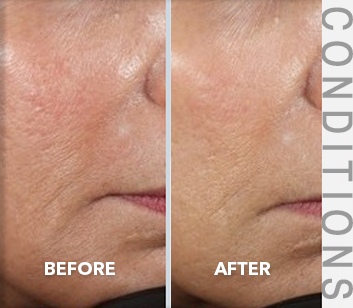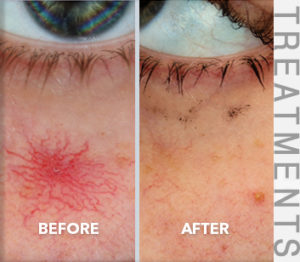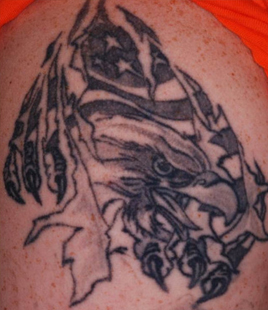Conditions
Laser Tattoo Removal in Philadelphia – Ardmore, PA
Results of Treatment
It may take 4-8 treatments to remove the tattoo. After treatment, one should apply petrolatum (Vaseline® or Aquaphor®) a few times a day and apply a non-stick dressing with paper tape.
About Tattoo Removal
Decorative tattoos have been placed on people’s bodies for well over 3,000 years. Today almost half of Americans aged 18-25 have at least one tattoo. However, a lot has changed even over the last ten years regarding tattoos and tattoo removal. Newer lasers now remove tattoos in fewer treatments. In addition, we often use multiple lasers to remove a single tattoo, since tattoos can become resistant to a single laser. Tattoos with multiple colored inks require a number of lasers used to be one of the more difficult colors to remove, and requires a special type of laser for removal.
The recent development of very short-pulsed lasers, called picosecond-domain lasers, has enabled much easier removal of blue, green and purple tattoo inks. Picosecond lasers deliver pulses that are less than a billionth of a second in duration. Previously, tattoo removing lasers had pulse durations in the 5-100 nanosecond (or 5-100 billionths of a second) range. Now with laser pulses less than a nanosecond, more tattoo pigments can easily be removed. For example, yellow tattoo ink was very resistant to removal by older Q-switched lasers. The newer picosecond lasers remove yellow ink in only 1-2 treatments. Lasers commonly used for tattoo removal include the Q-Switched Nd:YAG, Q-Switched ruby, Q-switched alexandrite lasers as well as the shorter pulse-duration picosecond-domain Nd:YAG, alexandrite, and titanium:sapphire lasers. Often a few lasers will be used to remove a single tattoo in the shortest number of treatments.
Black tattoos are generally the easiest to remove, since black tattoo pigments absorb every wavelength of laser light and the pigments are more easily fragmented and removed by the body. Green, blue and purple tattoos were often the most difficult colors to remove, but this is changing with the new picosecond lasers that remove these pigments much more effectively than previous-generation lasers. Generally, tattoos take 4-8, or more or less treatments to remove. This is quite a large range, and people generally want a more accurate estimate of the number of treatments required to remove a tattoo. Unfortunately, since there are such a huge range of tattoo inks, and since these inks aren’t regulated by the FDA, it’s extremely difficult to estimate the number of treatments required to remove a given tattoo. White inks, which are present in light blue, light green, pink and, of course, white tattoos can be very difficult or sometimes impossible to remove. White inks are composed of titanium oxide, zinc oxide and other pigments that often turn gray after laser treatment and then can be very difficult to remove. In contrast, amateur tattoos made with India ink can be removed in 1 or a few treatments. The bottom line is that modern tattoo-removing lasers do a great job of removing tattoos, but because people, tattoo inks and tattoo artists vary a great deal, so does the number of treatments required to remove a tattoo. However, one thing that is certain is that the newer tattoo-removing lasers are much more effective for all tattoo colors than lasers we were using only a decade ago.
We administer tattoo treatments at least 2 months apart. More than one laser may be used in a given treatment session to target multiple colors within a tattoo. First we numb the tattoo with lidocaine so the treatment doesn’t hurt, the numbing can be annoying, however. Following treatment, tattoos will be irritated similar to how they are after receiving a tattoo. The treatment site should be covered with petrolatum (Vaseline® or Aquaphor®) followed by a non-stick dressing and paper tape until the skin feels normal in 7-10 days. Good after-care and treatment with state-of-the-art lasers can erase an unwanted tattoo that was thought to be a permanent mistake.
To answer your specific questions or schedule a consultation, call Dr. Bernstein today at 610-645-5551.
Did you know?
Dr. Bernstein was the first physician in the WORLD to get the PicoWay®, PicoWay® 785 nm, and PicoWay® 730 nm and AlexTrivantage® lasers, the first in PA and one of the first in the U.S. to get the Wavelight® ruby laser and the first in the tristate area (PA, DE, NJ). He has published extensively on their use for treating tattoos.
Laser Tattoo Removal FAQs
HOW DOES A TATTOO STAY IN THE SKIN?
When artists place a tattoo in skin, they use rapidly moving needles to inject ink into the middle (dermis) of the skin. These ink particles are taken up by cells that live in the skin and aggregated. Ink particle within cells are not seen as foreign by the body and remain at the site of injection. Ink that is not taken up in cells is carried away via the lymphatics. These cells move a tiny bit over many years and are the reason older tattoos look as if they are smearing or spreading.
WHAT TYPES OF LASERS ARE USED TO REMOVE TATTOOS?
Modern lasers for treating skin use pulses of light to destroy the target they are aiming at while not hurting the surrounding skin. Larger targets are treated with longer pulses, because they require more light to heat them; while smaller targets are treated with very short pulses. In addition to the length of time each pulse takes, the color, or wavelength, of light is extremely important. The color of laser light must be absorbed by the target one is trying to remove. For example, a red laser cannot remove a red tattoo, because a red tattoo is red precisely because it does NOT absorb red light, but reflects it away at our eyes. That’s why it looks red. Red tattoos are removed with pulses of green light. So when removing tattoos, the laser must be of the proper color to be taken up by the particular color of ink in the tattoo, and the pulses must be short enough to target the microscopic cells containing the tattoo ink and not long enough to allow the heat that comes from absorption to be spread to the surrounding skin. If the pulse of light lasts too long, a scar can result. For this reason only Q-switched or picosecond-domain lasers, that emit pulses in the billionths of a second range or less, should be used to remove tattoos.
HOW MANY TREATMENTS DOES IT TAKE TO REMOVE A TATTOO?
I tell people it takes 4-8 or more or less treatments to remove a tattoo. That is not a very satisfying answer, but unfortunately there is too much variability in tattoo inks and the artists that place tattoos to give a better answer that that. Tattoo inks are not well regulate in the U.S., and in addition people respond variably to laser treatment for tattoo removal. One this is for certain, increasing the interval between treatments will result in few treatments to complete removal. One has to balance how quickly they want the tattoo off against how many treatments they are willing to have, as this affects the total cost of treatment.
WILL MY TATTOO BE COMPLETED REMOVED?
Many tattoos are completely removed. Complete removal requires returning for the necessary treatments, and being patient once a tattoo gets faint by waiting longer between treatments. With today’s picosecond lasers, complete removal of multicolored tattoos is much more likely.
CAN YOU REMOVE WHITE INK?
White ink is present in pink, light blue, light purple and light green as well as white itself. White inks are composed of zinc oxide and titanium dioxide and these compounds can turn gray after laser treatment and then may be difficult or impossible to remove. It’s important to understand this when deciding whether to remove a tattoo with these colors. Cosmetic tattoos such as: lip liner, eye liner, scar cover ups and some eyebrow tattoos may also turn gray upon laser treatments as they may contain zinc-, titanium- or iron-oxides as well.
IS IT EASY TO REMOVE COSMETIC TATTOOS?
Cosmetic tattoos such as: lip liner, eye liner, eyebrow, areola tattoos, and scar cover-ups may also turn gray after laser treatment as they may contain zinc-, titanium- or iron-oxides. Once this happens, other types of lasers, such as the CO2 laser may be used to injure the skin and allow the tattoo pigment to come to the surface. These tattoos can many times be removed, but the process is challenging and can take many treatments.
DOES LASER TATTOO REMOVAL HURT?
No, but that’s because we numb the tattoo before treatment. We use lidocaine injections administered with a very tiny needle or lidocaine cream to numb a tattoo before treatment. The numbing can be annoying, but people tolerate it well, and certainly a lot better than getting a tattoo or having one removed without lidocaine.
WHAT WILL MY TATTOO LOOK LIKE AFTER TREATMENT?
Following treatment, a tattoo can resemble what it looked like after it was applied. The skin will be red, inflamed and become crusty over the few days following treatment.
HOW DO I CARE FOR MY TATTOO AFTER TREATMENT?
Just like after a tattoo is applied, the skin is irritated, red, crusty and may even be blistered in some areas. After treatment one should apply petrolatum (Vaseline® or Aquaphor®) a few times a day and apply a non-stick dressing applied with paper tape.
WHAT CAN I DO IF I'M ALLERGIC TO MY TATTOO?
People can become allergic to their tattoos. Red ink is the most common ink color to elicit an allergic reaction. Yellow ink can cause an allergic reaction when exposed to sunlight, called a photoallergic reaction. A person can have an allergy to any tattoo color. Since laser treatment breaks up tattoo ink which is then carried away by the lymphatics, treating a tattoo causing an allergic reaction causes the offending pigment to be spread over a larger area. This can create a much more widespread allergic reaction and rarely a reaction that extends beyond the skin. One strategy to treat tattoos causing an allergic reaction is to inject them with corticosteroid injections at monthly intervals and wait for the body to remove the ink. Some physicians will pre-treat tattoos with corticosteroid injections, administer antihistamines and then treat with lasers. This may reduce the incidence or severity of more widespread reactions, but they could still occur. An alternative to small tattoos eliciting an allergic reaction is to excise them if the location is amenable.







